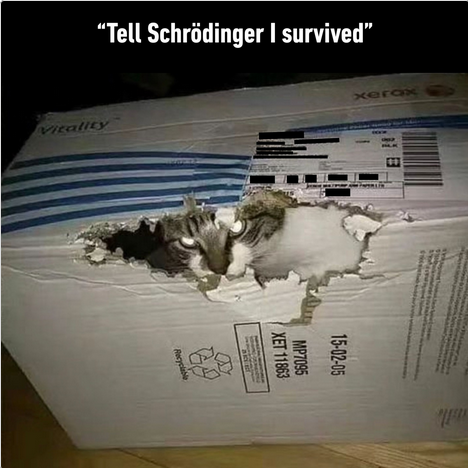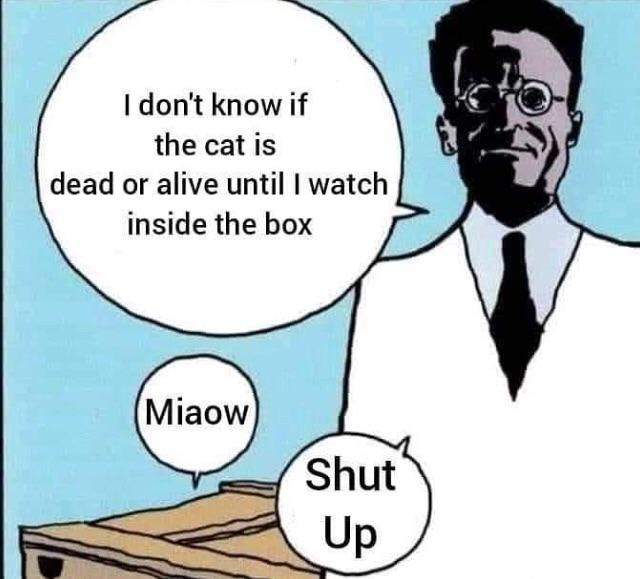
196
Be sure to follow the rule before you head out.
Rule: You must post before you leave.
AND I AM COMING FOR HIM.
I’d imagine most people here already know but the thought experiment was originally put out to show the absurdity of it and to poke fun.
Didn't know.
Most don't, because explaining the why beyond "just because you can't know which one is true doesn't mean it's both at the same time" gets funky.
Especially once you start saying "Okay, now this is why particles aren't real"
No i don't, i won't let physics friends to ruin my peace. Hey you, if you see this its annoying
IIRC, Erwin Schrödinger created the thought experiment as a critique of the popular theories surrounding quantum mechanics. (Wikipedia calls it Copenhagen interpretation, but I'm not a physicist so I'm not gonna pretend I know what that means.)
Again, I'm in no way qualified to explain this, but from what I've been able to understand, subatomic particles are constantly moving. Because they're constantly moving, it's not possible (by current means) to detect where any particle is at any given time. So, the best way scientists found to work with this constant movement was by assuming the particle was in more than one place at the same time.
Erwin Schrödinger, in a discussion with Albert Einstein, allegedly gave this analogy to describe the issue with this idea, that something simply can't be in multiple states at the same time. Ironically, this analogy became one of the most popular ways of explaining quantum physics.
Someone tell me I'm stupid if this is wrong or doesn't make sense.
"superposition is dumb and here's why" -schrödinger
I'm pretty sure the way it works is that you can't detect where a particle is exactly not because it's "always moving", it's cause it's literally impossible (since everything is a wave or something)
hopefully someone else can give a more complete answer
I'm relatively qualified. Studied physics all through college and spent a couple years working in quantum computing. I'll chime in here because Schrodinger's cat jokes are a pet peeve.
You are correct that, as far as we understand, it is literally impossible. There has been a competing theory for decades, but I'm not really up on the specifics https://en.wikipedia.org/wiki/De_Broglie%E2%80%93Bohm_theory. The reason it is generally rejected is that it appears to violate relativity.
Anyway.. the cat thought experiment is such a fun thought experiment to me because it specifically makes us think about a very practical issue with respect to quantum computing: decoherence. If you take his thought experiment to an extreme, it actually should be theoretically possible to create a state in which a macroscopic object (the cat) and a quantum object (the radioactive source) are indeed entangled. But that is absurd according to everything we've ever seen. So what's up? The missing concept here is decoherence -- while this state may theoretically exist, it'd decohere on timescales so small we can't even imagine. The fun connection here is that decoherence is the exact thing we're trying to fight in quantum computing. Essentially we're trying to make this thought experiment a reality for a much less complex system.
Some more on decoherence: https://en.wikipedia.org/wiki/Quantum_decoherence
So anyway how long until I can play Minecraft on a quantum supercomputer?
I'm just as you not a physesist but I'm still gonna take a bet at correcting you.
From what I know the "constantly moving" thing you to talked about is wrong (but the particles are probably always moving). I think what you where trying to get at is the fact that you can not measure a particles movement and position at the same time.¹
Those small quantum particles are not described by a position and a movement vector like normal objects but are instead described by a probability field, a so called "wave function". This function describes the probability that a particle is at a given position at a given time.² When two particles interact there waves merge and there now described by one wave (I have no idea how that works). Those particles then become "entangled" and share certain attributes.³ This is what happens with Schrödingers cat, the cat is entangled with the cat killing mechanism in the box. The cat can then be described by a probability thingy yielding not a absolute state for the cat but the probability that the cat is dead/alive.
There are many theories for how those values should be translated into the absolute world we see. One of those theories is, as you said, the Copenhagen theory. It states that when observerad all particles choose a state based on their wave function. It was, as you said, this theory that Schrödinger was arguing against.⁴ My favourite theory (based on its name) is the "shut up and calculate" theory.²
- Uncertainty principle - Swedish Wikipedia
- quantum mechanics- Swedish Wikipedia
- Quantum entanglement - Swedish Wikipedia
- "Parallels worlds probably exist. Here is why" - versarium YT
yes I just cited three articles in Swedish. but all of them should be available in English to :-)
Here is an alternative Piped link(s):
"Parallels worlds probably exist. Here is why" - versarium YT
Piped is a privacy-respecting open-source alternative frontend to YouTube.
I'm open-source; check me out at GitHub.
The Schrödinger's cat experiment is from 1935, the cat is dead.
Schrödinger's cat only "works" if the inside of the box is physically isolated from the environment. Maybe a faraday cage in freefall surrounded by vacuum. That's probably insufficient, but if you can still hear the meow then it's woefully insufficient.
What I hear every time I see this meme
Here is an alternative Piped link(s):
https://piped.video/3yGk6pNl6lA
Piped is a privacy-respecting open-source alternative frontend to YouTube.
I'm open-source; check me out at GitHub.
